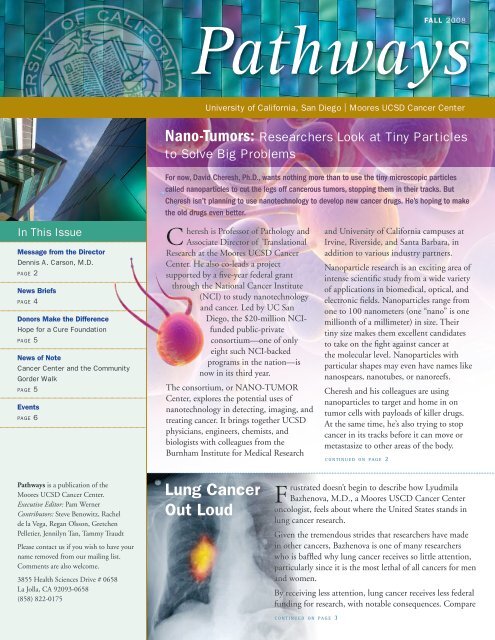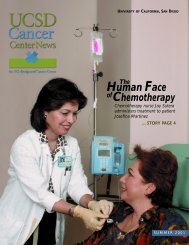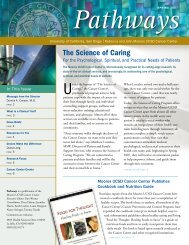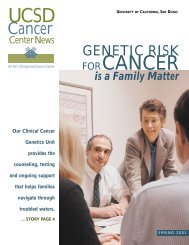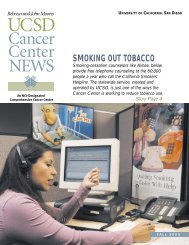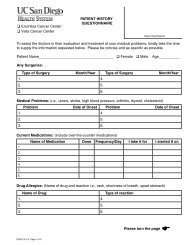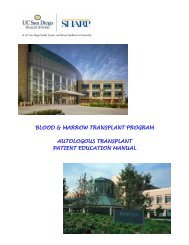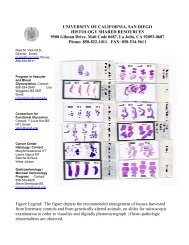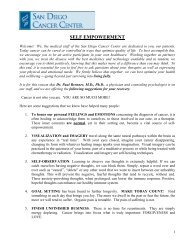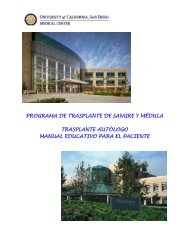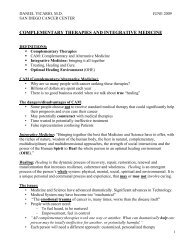lung Cancer Out loud - Moores Cancer Center - UC San Diego
lung Cancer Out loud - Moores Cancer Center - UC San Diego
lung Cancer Out loud - Moores Cancer Center - UC San Diego
You also want an ePaper? Increase the reach of your titles
YUMPU automatically turns print PDFs into web optimized ePapers that Google loves.
Pathways<br />
Fall 2008<br />
University of California, <strong>San</strong> <strong>Diego</strong> | <strong>Moores</strong> <strong>UC</strong>SD <strong>Cancer</strong> <strong>Center</strong><br />
Nano-Tumors: Researchers Look at Tiny Particles<br />
to Solve Big Problems<br />
In This Issue<br />
Message from the Director<br />
Dennis A. Carson, M.D.<br />
p a g e 2<br />
News Briefs<br />
p a g e 4<br />
Donors Make the Difference<br />
Hope for a Cure Foundation<br />
p a g e 5<br />
News of Note<br />
<strong>Cancer</strong> <strong>Center</strong> and the Community<br />
Gorder Walk<br />
p a g e 5<br />
Events<br />
p a g e 6<br />
For now, David Cheresh, Ph.D., wants nothing more than to use the tiny microscopic particles<br />
called nanoparticles to cut the legs off cancerous tumors, stopping them in their tracks. But<br />
Cheresh isn’t planning to use nanotechnology to develop new cancer drugs. He’s hoping to make<br />
the old drugs even better.<br />
Cheresh is Professor of Pathology and<br />
Associate Director of Translational<br />
Research at the <strong>Moores</strong> <strong>UC</strong>SD <strong>Cancer</strong><br />
<strong>Center</strong>. He also co-leads a project<br />
supported by a five-year federal grant<br />
through the National <strong>Cancer</strong> Institute<br />
(NCI) to study nanotechnology<br />
and cancer. Led by <strong>UC</strong> <strong>San</strong><br />
<strong>Diego</strong>, the $20-million NCIfunded<br />
public-private<br />
consortium—one of only<br />
eight such NCI-backed<br />
programs in the nation—is<br />
now in its third year.<br />
The consortium, or NANO-TUMOR<br />
<strong>Center</strong>, explores the potential uses of<br />
nanotechnology in detecting, imaging, and<br />
treating cancer. It brings together <strong>UC</strong>SD<br />
physicians, engineers, chemists, and<br />
biologists with colleagues from the<br />
Burnham Institute for Medical Research<br />
and University of California campuses at<br />
Irvine, Riverside, and <strong>San</strong>ta Barbara, in<br />
addition to various industry partners.<br />
Nanoparticle research is an exciting area of<br />
intense scientific study from a wide variety<br />
of applications in biomedical, optical, and<br />
electronic fields. Nanoparticles range from<br />
one to 100 nanometers (one “nano” is one<br />
millionth of a millimeter) in size. Their<br />
tiny size makes them excellent candidates<br />
to take on the fight against cancer at<br />
the molecular level. Nanoparticles with<br />
particular shapes may even have names like<br />
nanospears, nanotubes, or nanoreefs.<br />
Cheresh and his colleagues are using<br />
nanoparticles to target and home in on<br />
tumor cells with payloads of killer drugs.<br />
At the same time, he’s also trying to stop<br />
cancer in its tracks before it can move or<br />
metastasize to other areas of the body.<br />
c o n t i n u e d o n p a g e 2<br />
Pathways is a publication of the<br />
<strong>Moores</strong> <strong>UC</strong>SD <strong>Cancer</strong> <strong>Center</strong>.<br />
Executive Editor: Pam Werner<br />
Contributors: Steve Benowitz, Rachel<br />
de la Vega, Regan Olsson, Gretchen<br />
Pelletier, Jennilyn Tan, Tammy Traudt<br />
Please contact us if you wish to have your<br />
name removed from our mailing list.<br />
Comments are also welcome.<br />
3855 Health Sciences Drive # 0658<br />
La Jolla, CA 92093-0658<br />
(858) 822-0175<br />
Lung <strong>Cancer</strong><br />
<strong>Out</strong> Loud<br />
Frustrated doesn’t begin to describe how Lyudmila<br />
Bazhenova, M.D., a <strong>Moores</strong> USCD <strong>Cancer</strong> <strong>Center</strong><br />
oncologist, feels about where the United States stands in<br />
<strong>lung</strong> cancer research.<br />
Given the tremendous strides that researchers have made<br />
in other cancers, Bazhenova is one of many researchers<br />
who is baffled why <strong>lung</strong> cancer receives so little attention,<br />
particularly since it is the most lethal of all cancers for men<br />
and women.<br />
By receiving less attention, <strong>lung</strong> cancer receives less federal<br />
funding for research, with notable consequences. Compare<br />
c o n t i n u e d o n p a g e 3
Message from the Director<br />
s the <strong>Moores</strong> <strong>UC</strong>SD <strong>Cancer</strong> <strong>Center</strong> continues to<br />
expand our services and develop a far greater reach<br />
in the community, the <strong>Cancer</strong> <strong>Center</strong> is also undergoing<br />
some growing pains, not unlike the city of <strong>San</strong> <strong>Diego</strong>.<br />
While we continue to see more patients than ever before,<br />
and have recently recruited several new physicians, we<br />
still need more resources to meet the increasing demands<br />
placed on us by the community for patient services. We<br />
see this as a mark of our success, but also a continuing<br />
challenge for the future.<br />
Our newest faculty brings impressive credentials. Ithaar Derweesh, M.D., for<br />
example, who recently joined us from Tennessee, is a urologic oncologist who<br />
specializes in minimally invasive surgery techniques to treat, among other<br />
diseases, kidney cancer. As a scientist, Derweesh will be involved in testing the<br />
latest drugs to find innovative ways to combat kidney cancer, which is on the<br />
rise in this country.<br />
<strong>Moores</strong> <strong>Cancer</strong> <strong>Center</strong> physician-scientists continue to make substantial<br />
advancements in clinical research and have a number of outstanding clinical<br />
studies that are exploring the latest in potential therapeutic advances. Our<br />
oncologists are hoping to slow the progression of advanced <strong>lung</strong> cancer by<br />
treating patients with a novel kind of cancer vaccine designed to both pump<br />
up immunity while tricking the cancer into turning off its immune systemsuppressing<br />
activities. Leukemia researchers are examining the use of gene<br />
therapy for patients with chronic lymphocytic leukemia. In only one year, a<br />
unique partnership between industry and academia has led to human clinical<br />
trials of a new drug for a rare class of blood diseases called myeloproliferative<br />
disorders (MPD).<br />
The latter partnership and our ongoing efforts to establish relationships<br />
with local and regional biotechnology and pharmaceutical companies are<br />
additional indications of how connected we are to the <strong>San</strong> <strong>Diego</strong> community.<br />
We’re breaking down barriers and increasing collaborations. We’re finding<br />
new ways for industry and academia, historically sometimes worlds apart, to<br />
work together. The traditional barriers such as scientific secrecy, liability, and<br />
intellectual property rights are slowly being overcome. A recent symposium at<br />
the <strong>Cancer</strong> <strong>Center</strong> was aimed at fostering and strengthening the ties between<br />
scientists in the laboratory and experts at pharmaceutical and biotechnology<br />
companies to develop new, potentially valuable drugs against cancer. The<br />
<strong>Cancer</strong> <strong>Center</strong>’s role as an incubator of new ideas and research directions, as<br />
well as in evaluating promising new treatments and technologies, is vital for<br />
the benefit of our patients. As always, this is our focus—to get the newest,<br />
most effective therapies out of the laboratory and to our patients’ bedsides.<br />
Sincerely,<br />
A<br />
Nano-Tumor Research<br />
c o n t i n u e d f r o m f r o n t c o v e r<br />
His focus on starving tumors by shutting off<br />
their blood supply has led to new insights into<br />
understanding how tumors form and behave.<br />
Without a blood supply, tumors have no way<br />
to grow.<br />
Cheresh and his group recently developed a new<br />
treatment strategy using tiny “smart bombs”<br />
made of nanoparticles to target the spread of<br />
cancer with anti-cancer drugs. This summer<br />
they reported in the Proceedings of the National<br />
Academy of Sciences that a nanoparticle carrying<br />
a payload of chemotherapy drugs can specifically<br />
target proteins found on certain tumor blood<br />
vessels. The nanoparticle/drug combination<br />
didn’t have much impact on primary tumors,<br />
but it stopped pancreatic and kidney cancers<br />
from spreading in mice. As a result, the<br />
researchers needed lower amounts of dangerous<br />
drugs to stop the cancer from growing, and<br />
there was less damage to nearby normal tissue.<br />
It’s only the beginning, says Cheresh. “We’re<br />
building new particles that we think will be<br />
scalable for potential human use.”<br />
<strong>Cancer</strong> <strong>Center</strong> Project Scientist and<br />
immunologist Davorka Messmer, Ph.D., hopes<br />
to use nanotechnology to help the immune<br />
system recognize and kill tumor cells, rather<br />
than rely on drugs. She and her team are<br />
developing a vaccine using nanoparticles that<br />
attracts the immune system to the cancer and<br />
revs it up. But it hasn’t been easy. “Even if you<br />
successfully immunize, the tumor suppresses the<br />
immune response,” she explains. “We have to<br />
do a two-pronged approach. You’re pumping the<br />
gas pedal on the immune response, but it won’t<br />
be enough unless you take off the brakes—the<br />
immune suppression from the cancer.”<br />
While the research is in its early stages, Messmer<br />
is hopeful.<br />
“Eventually, we would like to have particles<br />
that don’t have to be tailored to the patient, but<br />
can be a general vaccine and with which the<br />
immune system can take care of the tumor,” she<br />
says. “Such a vaccine might be used to prevent a<br />
cancer from returning.”<br />
Dennis A. Carson, M.D.<br />
Director, <strong>Moores</strong> <strong>UC</strong>SD <strong>Cancer</strong> <strong>Center</strong><br />
Chugai Pharmaceutical Chair in <strong>Cancer</strong><br />
Associate Dean, <strong>UC</strong>SD Health Sciences<br />
2<br />
c o n t i n u e d o n p a g e 3
Lung <strong>Cancer</strong><br />
c o n t i n u e d f r o m f r o n t c o v e r<br />
Other NANO-TUMOR center projects<br />
include:<br />
• Developing “mother ships” that can<br />
home in on tumors and deliver smaller<br />
particles that could carry out a variety<br />
of jobs, including imaging tumors and<br />
releasing drugs<br />
• Creating nanoparticles that will<br />
clump in tumors and enable imaging<br />
and treatments<br />
• Studying nanoparticles that monitor<br />
genetic changes in cancer cells over time<br />
• Using nanotechnology to develop<br />
detection and monitoring systems for<br />
signs of cancer, and to follow the paths<br />
of drugs in the bloodstream.<br />
With two years left on the grant, Cheresh<br />
still has big plans. He and his team would<br />
like to use nanotechnology to package and<br />
target drugs more specifically to tumors,<br />
since some hit a range of targets in the<br />
body, not all of which are cancer. The<br />
same strategy, he says, could work for<br />
combinations of agents.<br />
He notes that his team is using imaging<br />
to see within hours whether a particle<br />
hits its target. “We’ve combined<br />
bioengineering, biochemistry, and biology<br />
with an engineering approach that involves<br />
designing a device that allows us to image<br />
blood vessels in real time,” he says.<br />
Cheresh is confident of nanotechnology’s<br />
potential. “I think in the next five to 10<br />
years, we will begin to see the real impact of<br />
nanotechnology in cancer and medicine.”<br />
five-year relative survival rates for women<br />
in 1975 and in 2000: for breast cancer,<br />
the rate went from 75 percent survival<br />
to 90 percent; for colorectal cancer, it<br />
went from 50 percent to 65 percent; but<br />
for <strong>lung</strong> cancer, the rate went from 15<br />
percent to 18 percent.<br />
“This disease needs more advocates,”<br />
says Bazhenova, whose clinical practice<br />
concentrates on <strong>lung</strong> cancer patients,<br />
with a focus on women and non-smokers.<br />
Bazhenova oversees cooperative group<br />
trials and designs and implements clinical<br />
investigations at the <strong>Moores</strong> <strong>Cancer</strong> <strong>Center</strong>.<br />
“We should learn from breast cancer<br />
patients, physicians, and researchers how<br />
to successfully raise awareness,” says<br />
Bazhenova. “There is a big stigma with<br />
<strong>lung</strong> cancer connected with smoking,<br />
yet 60 percent of our patients have never<br />
smoked or quit.”<br />
“That’s the very first thing out of<br />
someone’s mouth when you tell them<br />
you have <strong>lung</strong> cancer: ‘Did you smoke’”<br />
says Sheila Inman, one of Bazhenova’s<br />
patients. “It’s a way of asking, ‘Did you<br />
do this to yourself’”<br />
Another patient, Mary Lebkuecher, was<br />
one of the 1,308 new <strong>lung</strong> cancer cases<br />
diagnosed in <strong>San</strong> <strong>Diego</strong> County in 2006,<br />
and she is among the 20 percent of <strong>lung</strong><br />
cancer patients who has never smoked.<br />
After a poor prognosis, Mary sought<br />
Bazhenova for a second opinion. “My<br />
first doctor gave me six months to live,<br />
so when I met with Dr. B for a second<br />
opinion I was desperate,” she says. “But<br />
she gave me hope. And today it’s been a<br />
year since my diagnosis,” says Mary.<br />
Although she didn’t qualify for<br />
participation in a clinical trial, Mary<br />
is still experiencing the value of<br />
academic medicine via Bazhenova’s<br />
experience as a clinician, researcher,<br />
and teacher. Bazhenova placed Mary on<br />
the drug Tarceva and treated her with<br />
chemotherapy and radiation.<br />
Both<br />
Mary and<br />
Sheila were<br />
astonished<br />
when they<br />
received a <strong>lung</strong><br />
cancer diagnosis, particularly since they<br />
lead healthy and active lives. “I’m only<br />
the second person in my family who has<br />
been diagnosed with cancer, and I have a<br />
large family,” says Sheila Inman. Sheila’s<br />
cancer was discovered because of a blood<br />
clot in her leg. “I went back and looked<br />
at a pamphlet I’d received a couple years<br />
ago when I had my first clot, and there<br />
it was: blood clots can be a symptom of<br />
<strong>lung</strong> cancer.” As a non-smoker, it never<br />
occurred to her to connect the two.<br />
The next shock for these women was<br />
the comparative lack of research and<br />
treatments.<br />
“Initially you just assume it’s like a lot of<br />
cancers,” says Sheila. “We were hoping<br />
there would be options, and it could be<br />
cured or managed. It’s just shocking.”<br />
Shocking, yes. According to the American<br />
<strong>Cancer</strong> Society, <strong>lung</strong> cancer is the leading<br />
cause of cancer death, and more people<br />
die from <strong>lung</strong> cancer than of colon,<br />
breast, and prostate cancers combined.<br />
Lung cancer is also the leading cancer<br />
killer of women in the United States,<br />
claiming nearly twice as many lives as<br />
breast cancer. Nearly 20 percent of these<br />
deaths are in women who have never<br />
smoked. In fact, women who have never<br />
smoked are at greater risk for <strong>lung</strong> cancer<br />
than men who have never smoked. This is<br />
why more research is desperately needed.<br />
Meanwhile, Mary Lebkuecher and Sheila<br />
Inman aren’t waiting. They’re fighting<br />
<strong>lung</strong> cancer with the most targeted<br />
treatments available at the <strong>Moores</strong><br />
<strong>Cancer</strong> <strong>Center</strong>. And with Bazhenova’s<br />
encouragement, they’re talking about<br />
<strong>lung</strong> cancer.<br />
3
News Briefs<br />
2008 Nobel Prize in Chemistry Shared by <strong>Moores</strong> <strong>UC</strong>SD <strong>Cancer</strong> <strong>Center</strong> Member<br />
Roger Tsien, Ph.D.<br />
A rendering of GFP and<br />
a peptide.<br />
<strong>UC</strong> <strong>San</strong> <strong>Diego</strong> researcher and <strong>Moores</strong> <strong>UC</strong>SD <strong>Cancer</strong> <strong>Center</strong><br />
member Roger Tsien, Ph.D., will share the 2008 Nobel Prize<br />
in Chemistry with Osamu Shimomura of the Marine<br />
Biological Laboratory in Woods Hole and Boston University<br />
School of Medicine and Martin Chalfie of Columbia<br />
University in New York. The scientists are being honored for<br />
the discovery of Green Fluorescent Protein (GFP) and for their<br />
work to design and create glowing molecules that enter cells<br />
and light up their inner workings.<br />
Tsien, Professor of Pharmacology, Chemistry, and Biochemistry<br />
and a Howard Hughes Medical Institute Investigator, has<br />
dedicated his career to the development and application of<br />
fluorescent protein probes that enable scientists to monitor<br />
how cells work. He and his collaborators have engineered dyes<br />
that can get inside cells leading to new opportunities to<br />
monitor and image various processes in cells, including tracking<br />
when and where genes are turned on and off. Such fluorescent<br />
proteins have potentially wide-ranging uses in neurobiology<br />
and cancer. Most recently, Tsien has begun to build on this<br />
work to develop a novel way to image and possibly even deliver specially targeted<br />
drugs to cancer tumors, and is trying to translate these approaches to the clinic.<br />
Longboard & Luau Raises Half a Million For <strong>Cancer</strong> Research<br />
The surf was up at the August 24 “Luau and Longboard Invitational” near the Scripps<br />
Institution of Oceanography pier, in La Jolla where guests, surfing legends, scientists,<br />
business leaders, and cancer patients and survivors came together to celebrate 15 years<br />
of surfin’ for a cure. Thanks to Title Sponsor Pfizer La Jolla and Gold Sponsor<br />
Genentech Oceanside, this year’s event raised more than half a million dollars for<br />
cancer research for the <strong>Moores</strong> <strong>UC</strong>SD <strong>Cancer</strong> <strong>Center</strong>. In total, the Luau has raised<br />
more than $3 million.<br />
The event highlight was the presentation of the Rell Sunn “Queen of Makaha” Award,<br />
which was established in memory of Sunn, a Hawaiian surfer and longtime Luau and<br />
Longboard Invitational supporter who lost her battle to breast cancer. Each year, the<br />
award is given to an individual for his or her dedication to helping others in the fight<br />
against cancer in ways that<br />
embody the true “aloha” spirit.<br />
This year’s recipient was Doris A.<br />
Howell, M.D., Founder of <strong>San</strong><br />
<strong>Diego</strong> Hospice and namesake of<br />
the palliative and supportive care<br />
service at the <strong>Moores</strong> <strong>Cancer</strong><br />
<strong>Center</strong>. Howell was recognized<br />
for her selfless devotion to the<br />
care of others, especially those<br />
whose lives have been affected by<br />
cancer.<br />
Surf Legend Rusty Preisendorfer with Title Sponsor, “Team Pfizer.”<br />
4<br />
“Everything is Possible<br />
Celebration”<br />
Seany Foundation Raises Funds<br />
for Ewing’s Sarcoma Research<br />
Amy & Mitch Robins with Dyan & Barry Abrams.<br />
On August 3, the <strong>Moores</strong> <strong>UC</strong>SD <strong>Cancer</strong><br />
<strong>Center</strong> lobby and the Ben and Sheri<br />
Kelts Bamboo Court were transformed<br />
into a magical sunflower garden for the<br />
“Everything is Possible Celebration.” Amy<br />
and Mitch Robins, founders of the Seany<br />
Foundation, coordinated and underwrote<br />
this special evening, which included unique<br />
silent and live auction items, including a<br />
private dinner prepared by executive chef<br />
Jeffrey Strauss of Pamplemousse Grill.<br />
The Seany Foundation is named after the<br />
Robins’ beloved son Sean, who lost his<br />
battle to Ewing’s sarcoma in November<br />
2006. The celebration raised more than<br />
$75,000 for the Sean Lewis Robins<br />
Endowed Research Fund at the <strong>Moores</strong><br />
<strong>Cancer</strong> <strong>Center</strong>. As Mitch said, “This is<br />
what Sean would have wanted.”<br />
i n v i tat i o n t o j o i n t h e<br />
Health Sciences Associates<br />
You are personally invited to join the <strong>UC</strong><br />
<strong>San</strong> <strong>Diego</strong> Health Sciences Associates. The<br />
Health Sciences Associates is a new recognition<br />
program that recognizes our most generous<br />
donors who make annual leadership gifts of<br />
$1,000 or more to one or more areas within<br />
Health Sciences. Associates are vital to<br />
sustaining excellence in quality patient care,<br />
exceptional education, valuable research, and<br />
ongoing service to the community.<br />
To learn more, visit http://hsassociates.ucsd.edu, or call<br />
(619) 543-3473.
Hope for a Cure Foundation<br />
“Doing research is like searching for a door<br />
in a dark room,” Jean Wang, Ph.D., told<br />
the gathering at the Hope for a Cure<br />
Foundation’s annual fundraiser. “Your gift<br />
of the digital imaging system is like a light<br />
that helps us find the door!”<br />
Wang, Professor and Associate Director of<br />
Basic Research at the <strong>Moores</strong> <strong>UC</strong>SD<br />
<strong>Cancer</strong> <strong>Center</strong>, described how the research<br />
equipment donated by the Hope for a Cure<br />
Foundation would help her lab identify<br />
new drug targets to improve cancer<br />
chemotherapy.<br />
The Hope for a Cure Foundation purchases<br />
equipment for local cancer research<br />
institutes—equipment not covered by<br />
grants and individual donations.<br />
Board members Eva Borgstrom, Olga<br />
Fisher, Maryjo Highland, Dee Jerge, and<br />
Pam Xitco volunteer their time and<br />
expertise to keep overhead at an absolute<br />
minimum. All the funds raised stay in <strong>San</strong><br />
<strong>Diego</strong> to advance programs already in place.<br />
The Foundation has made a difference to<br />
Researchers Jean Wang, Ph.D., and<br />
Shun J. Lee with Foundation board members<br />
Olga Fisher, Maryjo Highland, Eva Borgstrom,<br />
Pam Xitco, and Dee Jerge.<br />
other <strong>Moores</strong> <strong>Cancer</strong> <strong>Center</strong><br />
physicians. Anne Wallace, M.D.,<br />
recently received powerful equipment<br />
that records and maps the duct wall of<br />
breast cancer patients.<br />
J. Kellogg “Kelly” Parsons, M.D.,<br />
received new equipment to assist in his<br />
research into the links between diet and<br />
prostate cancer. The new fluoroscopic<br />
unit will help Parsons analyze dietary<br />
compounds important for cancer<br />
prevention and control.<br />
An investment you can count on…<br />
News of Note<br />
Taking the <strong>Cancer</strong> <strong>Center</strong> to<br />
the Community<br />
Lynn and Richard Gordon with Catriona Jamieson,<br />
M.D., Ph.D.<br />
A unique summer gathering brought both<br />
awareness and knowledge about cancer<br />
stem cell research to friends and family who<br />
gathered at the home of <strong>Moores</strong> <strong>UC</strong>SD<br />
<strong>Cancer</strong> <strong>Center</strong> Board member Lynn and<br />
Richard Gordon. The Gordons introduced<br />
their friends to Catriona Jamieson, M.D.,<br />
Ph.D., Assistant Professor and Director of<br />
Stem Cell Research at the <strong>Moores</strong> <strong>Cancer</strong><br />
<strong>Center</strong>, who provided insightful information<br />
on her stem cell research and collaborations<br />
with fellow researchers over coffee and<br />
dessert. Guests spoke personally with<br />
Jamieson, who enjoyed the opportunity to<br />
meet members of our community.<br />
When you create a charitable gift annuity<br />
with the <strong>UC</strong> <strong>San</strong> <strong>Diego</strong> Foundation, you<br />
invest not only in the University but your<br />
future as well.<br />
A charitable gift annuity with the<br />
Foundation provides you certain benefits<br />
on your investment, including: a charitable<br />
income tax deduction; fixed annuity<br />
payments for life; and the satisfaction that<br />
your gift will eventually help the <strong>Moores</strong><br />
<strong>UC</strong>SD <strong>Cancer</strong> <strong>Center</strong> fulfill its vision to<br />
translate promising scientific discoveries into<br />
new and better treatments for our patients.<br />
There are plenty of uncertain investments—<br />
but a gift annuity with <strong>UC</strong> <strong>San</strong> <strong>Diego</strong> isn’t<br />
one of them. And that’s one reason so many<br />
of our friends participate in this program.<br />
For a simple, no-obligation illustration to<br />
Sample Gift Annuity Payment Rates<br />
Selected Rates for<br />
One Person<br />
Selected Rates for Two<br />
Persons of the Same Age<br />
Age Rate Ages Rate<br />
65 5.7% 65/65 5.4%<br />
70 6.1 70/70 5.6<br />
75 6.7 75/75 6.0<br />
80 7.6 80/80 6.6<br />
85 8.9 85/85 7.4<br />
90+ 10.5 90/90 8.7<br />
For illustrative purposes only. Please contact us<br />
for current rates benefits and rates for other ages.<br />
show you how a gift annuity can work for<br />
you, please contact Geoff Graham, Director<br />
of Development, in our Office of Planned<br />
Giving at (858) 534-2249, or e-mail<br />
gcgraham@ucsd.edu. And visit our Web site<br />
at www.plannedgiving.ucsd.edu.<br />
5<br />
Gorder 5k Walk Hits the<br />
Million Dollar Mark<br />
The 15th Annual Bruce Gorder <strong>UC</strong>SD 5K<br />
Walk for Melanoma held on Saturday,<br />
October 11, brought supporters of all ages<br />
together to raise money and awareness for<br />
melanoma research at<br />
the <strong>Moores</strong> <strong>UC</strong>SD<br />
<strong>Cancer</strong> <strong>Center</strong>.<br />
Honorary chair for the<br />
Walk and emcee Bill<br />
Griffith from Channel<br />
10 News welcomed<br />
registrants. Participants<br />
enjoyed a route that<br />
wound through the campus amid its fragrant<br />
eucalyptus trees and the Stuart Art Collection.<br />
c o n t i n u e d o n b a c k p a g e
News of Note<br />
c o n t i n u e d f r o m p a g e 5<br />
The event, established by <strong>Cancer</strong> <strong>Center</strong><br />
board member Charles “Chuck” F. Gorder,<br />
Sr., has raised more than $1 million dollars<br />
since 1992. It honors Chuck’s son, Bruce,<br />
who lost his battle against melanoma at the<br />
age of 37. Chuck and his wife Rhona have<br />
served as event chairs for many years.<br />
“The Melanoma Walk is important to my<br />
family,” said Chuck. “Our hope has always<br />
been that the funds raised from this event<br />
will help fight the battle against cancer, so<br />
that in the future, families won’t have to<br />
lose a loved one.”<br />
Events<br />
Thursday, January 29, 2009<br />
“Doctor-Patient Communication”<br />
Speaker: Lidia Schapira, M.D.<br />
<strong>Moores</strong> <strong>UC</strong>SD <strong>Cancer</strong> <strong>Center</strong>, Goldberg Auditorium<br />
6:00 - 8:00 PM<br />
Wednesday, March 11, 2009<br />
Faculty Ambassador Event<br />
“Understanding Lung <strong>Cancer</strong>”<br />
Speaker: Lyudmila Bazhenova, M.D.<br />
<strong>Moores</strong> <strong>UC</strong>SD <strong>Cancer</strong> <strong>Center</strong>, Goldberg Auditorium<br />
6:00 – 8:00 PM<br />
Saturday, May 16, 2009<br />
28th Annual Celebrity Chefs Cook Gala<br />
Epicurean Elegance<br />
Sheraton <strong>San</strong> <strong>Diego</strong> Hotel & Marina<br />
6:00 – 11:00 PM<br />
Community Event Partners<br />
The <strong>Moores</strong> <strong>UC</strong>SD <strong>Cancer</strong> <strong>Center</strong> is grateful to<br />
our community event partners: individuals and<br />
organizations who host fundraising events to<br />
benefit cancer research.<br />
Interested in Planning an Event<br />
Please contact Tammy Traudt at (858)822-1390<br />
or ttraudt@ucsd.edu.<br />
Helping You<br />
Get Connected!<br />
General information<br />
(858) 534-7600<br />
New patients<br />
(858) 822-6100 or<br />
toll-free (866) 773-2703<br />
Clinical trials<br />
(858) 822-5354<br />
If you are a physician<br />
(888) 822-8741<br />
Charitable donations<br />
(858) 822-0175<br />
Web site<br />
www.cancer.ucsd.edu<br />
Volunteer Services<br />
(619) 543-6370<br />
<strong>Moores</strong> <strong>UC</strong>SD <strong>Cancer</strong> <strong>Center</strong><br />
President of the Board<br />
Rudolph Rehm<br />
cancer center<br />
board of directors<br />
J. Samuel Armstrong, IV<br />
Gordon P. Boerner<br />
Marilynn Boesky<br />
Carol Littlejohn Chang<br />
Howard I. Cohen<br />
William T. Comer, Ph.D.<br />
Daniel J. Gatto<br />
Frank M. Goldberg<br />
Charles F. Gorder, Sr., Esq.<br />
Lynn Gordon<br />
Donald W. Grimm<br />
Jerome S. Katzin, Esq.<br />
Jeffrey Lipinsky<br />
Cinda K. Lucas<br />
Henry L. Nordhoff<br />
John W. Otterson, II<br />
Justin Renaudin, M.D.<br />
Mary Rand Taylor<br />
Carol Vassiliadis<br />
ex officio members<br />
Marye Anne Fox, Ph.D.<br />
David A. Brenner, M.D.<br />
Debra Neuman<br />
Wayne Bardwell, Ph.D.<br />
Suzanne Agarwal<br />
John Kay<br />
Jessica Yingling<br />
directors emeritus<br />
Joany Mosher<br />
Anne Otterson<br />
Director<br />
Dennis A. Carson, M.D.<br />
Deputy Director<br />
Research Operations<br />
Thomas J. Kipps, M.D., Ph.D.<br />
Medical Director<br />
Oncology Services<br />
Barbara A. Parker, M.D.<br />
Associate Director<br />
Administration<br />
Ira S. Goodman<br />
Director of Development<br />
Pamela M. Werner, CFRE<br />
Pathways<br />
fall 2008<br />
University of California, <strong>San</strong> <strong>Diego</strong> | Rebecca and John <strong>Moores</strong> <strong>UC</strong>SD <strong>Cancer</strong> <strong>Center</strong><br />
Non-Profit Org.<br />
U.S. Postage<br />
P A I D<br />
3855 Health Sciences Drive #0658<br />
<strong>San</strong> <strong>Diego</strong>, CA<br />
La Jolla, CA 92093-0658<br />
Permit No. 1909


